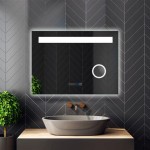Can You Use Screen Mirroring Without Wifi?
Screen mirroring, the act of replicating a device's display on a larger screen, has become an increasingly popular feature. While Wi-Fi is often the go-to method for this technology, various alternative methods exist for establishing a connection and sharing content wirelessly or through physical connections. This article explores these different approaches and their respective advantages and disadvantages.
Wired Connections for Screen Mirroring
Several wired options bypass the need for Wi-Fi when mirroring a screen. These methods offer a stable and reliable connection, particularly beneficial for situations requiring high bandwidth, such as gaming or streaming high-definition video.
*
HDMI Cables:
A High-Definition Multimedia Interface (HDMI) cable provides a direct, high-bandwidth connection between devices. Simply connect one end of the HDMI cable to the source device (e.g., smartphone, laptop) and the other to the display device (e.g., television, monitor). This method is generally plug-and-play and offers excellent video and audio quality. *USB-C to HDMI Adapters:
For devices equipped with a USB-C port, an adapter can be used to convert the signal to HDMI. This is particularly useful for newer laptops and smartphones that may lack a dedicated HDMI port. Functionality and performance are similar to a direct HDMI connection. *Lightning to HDMI Adapters:
Apple devices, such as iPhones and iPads, utilize the Lightning connector. Similar to USB-C adapters, Lightning to HDMI adapters enable screen mirroring to HDMI-compatible displays. *MHL Cables:
Mobile High-Definition Link (MHL) is another wired option specifically designed for mobile devices. MHL cables connect a device’s micro-USB port to an HDMI port on the display. However, MHL is becoming less common with newer devices.Wireless Screen Mirroring Without Wi-Fi
While Wi-Fi is frequently used for wireless screen mirroring, alternative wireless technologies can achieve the same result. These methods can be useful when a Wi-Fi network is unavailable or unreliable.
*
Miracast:
This peer-to-peer wireless technology allows direct connection between devices without needing a Wi-Fi network. Miracast uses Wi-Fi Direct, a standard allowing devices to connect directly to each other. Compatibility varies between devices; both the sending and receiving devices must support Miracast for it to function. *Bluetooth:
While primarily associated with audio, some devices support video transmission over Bluetooth. However, bandwidth limitations can result in lower resolution and potential latency issues. This method is less suitable for high-quality video mirroring. *DLNA:
The Digital Living Network Alliance (DLNA) protocol enables media sharing and streaming across compatible devices on a local network. While not strictly screen mirroring, DLNA allows users to view photos, videos, and music from their device on a larger display without Wi-Fi, provided they are connected to the same wired or wireless local network. *AirPlay (with caveats):
While AirPlay typically relies on Wi-Fi, some newer Apple devices support peer-to-peer AirPlay using Bluetooth and Wi-Fi Direct. This functionality allows limited screen mirroring without being connected to the same Wi-Fi network, but performance and compatibility can vary.Device-Specific Screen Mirroring Solutions
Certain manufacturers offer proprietary solutions for screen mirroring that may not rely on traditional Wi-Fi. These often provide seamless integration within their respective ecosystems.
*
Samsung Smart View:
This feature allows Samsung devices to connect and share content with compatible Samsung smart TVs. While typically using Wi-Fi, some versions support Bluetooth connections for certain functions, although full screen mirroring may still require Wi-Fi. *Chromecast Built-in (with caveats):
Devices with Chromecast built-in can often mirror content to Chromecast-enabled displays. While commonly used over Wi-Fi, some functionalities like "Guest Mode" may allow limited casting without being on the same Wi-Fi network, relying on an ultrasonic audio handshake for setup.Considerations When Choosing a Screen Mirroring Method
Selecting the appropriate screen mirroring method depends on several factors:
*
Device Compatibility:
Ensure both the sending and receiving devices support the chosen method. Check for compatibility with HDMI, Miracast, specific adapters, or other relevant technologies. *Content Type:
The content being mirrored influences the required bandwidth. High-definition video requires a higher bandwidth connection than displaying static images or presentations. *Required Quality:
Consider the desired video and audio quality. Wired connections generally provide the best quality, while wireless options can be subject to compression and latency issues depending on the technology used. *Distance and Mobility:
Wired solutions limit mobility due to cable length restrictions. Wireless options offer greater flexibility but may be susceptible to interference and range limitations. *Ease of Use:
Some methods offer a simpler setup and connection process than others. Plug-and-play solutions like HDMI cables are generally the easiest to use, while wireless methods may require some configuration. *Latency:
Latency refers to the delay between an action on the source device and its reflection on the display. For activities like gaming, low latency is crucial, making wired connections preferable. *Security:
When using wireless methods, ensure secure connections to prevent unauthorized access to the mirrored content.Troubleshooting Screen Mirroring Issues
If encountering difficulties with screen mirroring, consider these troubleshooting steps:
*
Verify Compatibility:
Double-check that both devices support the selected mirroring method. *Check Cables and Connections:
Ensure cables are securely connected and undamaged. Try a different cable or port if necessary. *Update Software and Drivers:
Outdated software or drivers can cause compatibility issues. Ensure both devices are running the latest available versions. *Restart Devices:
A simple restart can often resolve temporary software glitches affecting screen mirroring. *Check Network Settings (for Wireless Methods):
If using wireless mirroring, ensure devices are on the same network and that network settings allow communication between devices. Disable any firewalls or network restrictions that may be blocking the connection.
How To Mirror Phone Screen Without Wifi 4 Simplest Way Help

How To Screen Mirror Without Wifi 2024 Updated

2024 Tutorial How To Mirror Phone Tv Without Wi Fi

How To Screen Mirror Iphone Ipad Without Wifi 3 Ways Airplay Guru

How To Mirror Phone Screen Without Wifi 4 Simplest Way Help

Do You Need Wifi To Screen Mirror

How To Screen Mirroring Any Android Phone Tv Without Wifi

Best Ways To Mirror Iphone Pc Via Usb Without Wifi

3 Ways To Mirror Iphone Tv Without Apple Istreamer

2024 Updated How To Mirror Android Pc Without Wi Fi








